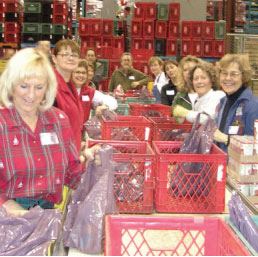
The Strength of Culture: How you engage people is critical to success!
|
|
James McAra, has been with the Calgary Food Bank since 2000 and the CEO since 2007. He cannot overstate the importance to the organization of their 4,500 volunteers. "We view all these people as part of our organization, not add-ons." This sincere engagement with volunteers helps the Calgary Food Bank perform better, improves the organizational culture and ultimately feeds more people with better food.
THE POWER OF VOLUNTEERISM
Traditional volunteerism has been in the form of a ‘nice to have’. For many charitable organizations staff are the primary performance group and are usually the focus of the culture. However, volunteers have valuable skills that would otherwise be unavailable. The Calgary Food Bank engages volunteers and staff at the same level and with the same expectations, the Calgary Food Bank encourages participation and integration of skills. Staff and volunteers can learn from each other and thus bring wider knowledge into the organization.
All this has a positive influence on productivity, cooperation and innovation. These traits have been particularly important following the significant increase in demand since 2008. Not only has the Calgary Food Bank seen increased volunteer engagement, but more food has been sorted, shared and distributed. While the voluntary sector has suffered due to a lack of volunteer response, the Calgary Food Bank thrived and engaged more volunteers.
"Our strategy," says McAra, "is to bring the community into the organization in as many ways as possible. "Walk the Talk" surrounds the Calgary Food Bank and by showing people we are proud of it, and inviting them to become part, we continue to invigorate volunteers." Potential volunteers come as a tour, others as a group, some just want to find out what Calgary Food Bank is about, and others want a place to have a meaningful experience until their life shifts to another job, location or path.
THE ONGOING NEED
A food bank should not need to exist, but they do in virtually every city in Canada. Changes in public policy and how Canadians view their responsibilities to friends, family, employers, and community brought food banks into existence over 30 years ago. In that period, people wanted to be engaged and know that where the economy and government had failed, communities could rally together to ensure no one got left behind. Maximizing the effects of charity across the community was a true and highly valued social return on investment. The benefit was stronger communities.
Ground-breaking research done by the Calgary Food Bank demonstrated that 86% of client families needing food will come once or twice in a ten year period. This evidence combined with an understanding of outcomes supports the benefit of early intervention and strong resource placement: knowing where the food, funds and time donated to the organization will make the most impact. Combining this with an effective and efficient organization will ensure that unpredictable changes in demand will not negatively impact the community.
Food banks bring people together not to compete for scarce financial support but to bring food, time and funds together. Each element is crucial but all three work together to create a high-performing and sustainable culture.
LONG TERM VISION
McAra states that the Calgary Food Bank has recently adopted a longer term vision. "We know that until society and public policy change, there will be a need for food banks. It is not responsible to be planning short term when you have no evidence of pending change. By pursuing a scalable organization the Calgary Food Bank is able to act in accordance to community need, not react through disaster response." McAra positions food banks like the Red Cross, as triage and support systems to families in need. "Providing food in the short term doesn’t replace the need for policy changes over the longer term. We’re not waiting for that though. The Food Bank is being positioned to scale supports or modify food distribution to areas of greater need."
A strong culture with engaged staff and volunteers, combined with solid business principles, has lead to remarkable ‘bottom line results’ in providing a social benefit for the City of Calgary and province of Alberta. Many of the practices employed by this leading non-profit organization can serve as a model for all businesses.
THE BOTTOM LINE
Charity Intelligence Canada (CIC) does research and analysis to help donors make their own giving decisions. For the past four years, CIFB has been a Top Charity Pick. In the latest report of August 2011, CIC highlighted these accomplishments:
SUPERIOR LOGISTICS
What it takes per week Collecting, storing and distributing this vast amount of food and produce places an onus on superior logistics and coordination. Here’s what it takes every week:
 4,500 volunteers keep the Food Bank running smoothly |
Categories: Bottom Line

